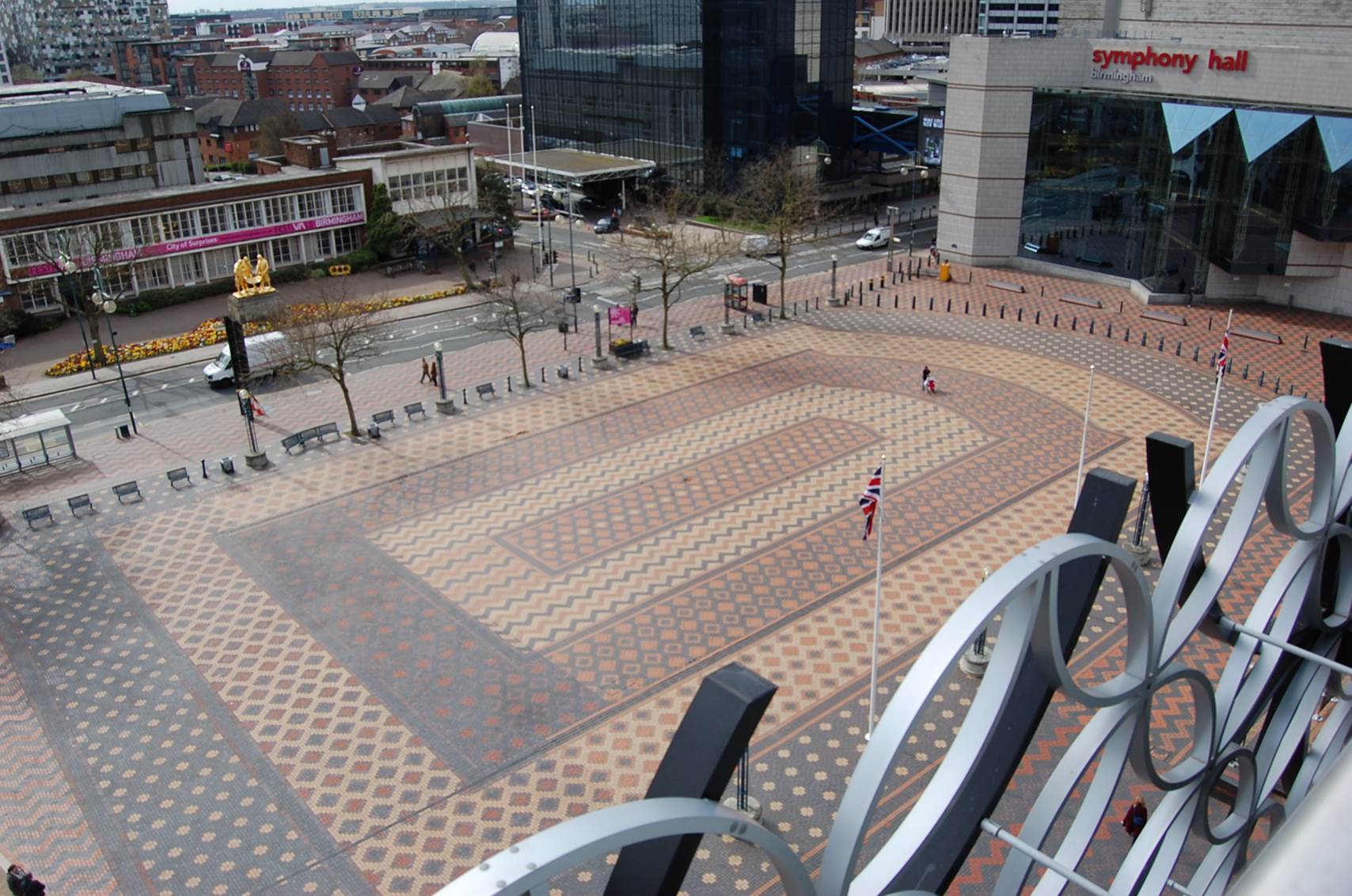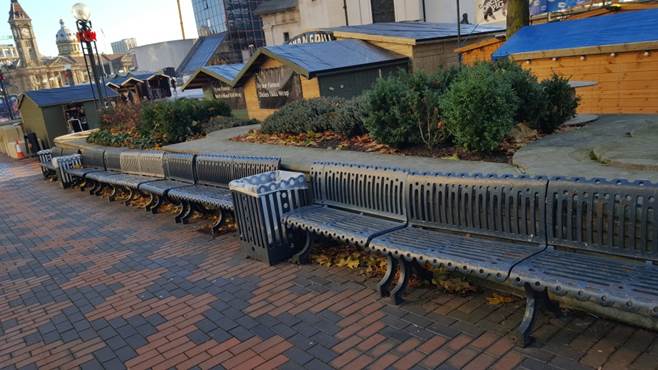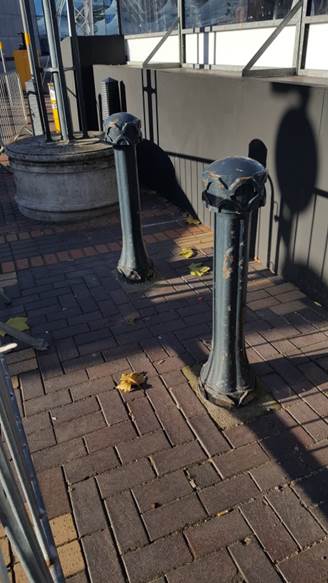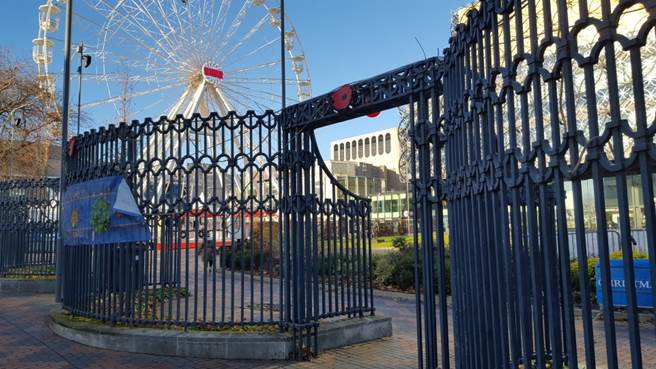Centenary Square artwork decommission including street furnishings
Feedback updated 20 Apr 2017
We asked
An open call out for organisations interested in being gifted benches, bins, railings and bollards from Centenary Square to submit an expression of interest.
We also asked whether there was any feedback on the process and decision to decommission Tess Jary's Carpet artwork from Centenary Square.
You said
Ten organisations expressed an interest in receiving street furniture items from Centenary Square.
There were no comments on the process and decision to decommission Tess Jary's Carpet artwork from Centenary Square.
We did
Of these ten organisations, at least six organisations will receive a selection of railings, bins, benches, bollards. The railings have been allocated for use around the Peace Gardens, and other items will be gifted to various high streets and one park.
There was little interest in the lamp columns but all other street furniture items have been allocated.
A selection of items to be gifted to the Birmingham Museums Trust, ensuring a sample of the heritage of the centenary celebration will be kept in a public collection for future generations.
Results updated 20 Apr 2017
Ten organisations expressed an interest in receiving street furniture items from Centenary Square. Of these ten organisations, six organisations will receive a selection of railings, bins, benches, bollards. There was little interest in the lamp columns but all other street furniture items have been allocated. This includes a selection of items to be gifted to the Birmingham Museums Trust, ensuring a sample of the heritage of the centenary celebration will be kept in a public collection for future generations.
Overview

In 1988, artist Tess Jaray was commissioned by Birmingham City Council to design the public realm environment for Centenary Square. Completed in 1991, the artwork comprises of standard paving blocks laid on sand in a Persian carpet pattern and a complimentary designed suite of decorative street furniture including railings, bins, benches, bollards and light columns.
Centenary Square will be redeveloped in 2017. The artwork has been enjoyed for 25 years, longer than the life-time of one of the key component material (paving blocks), many of which are broken and have been replaced due to heavy vehicles on the site. The use of the square has changed over this time and is host to the annual Christmas markets, Big Wheel and ice rink, amongst other high-profile cultural events. Together, the near-by Paradise development, arrival of the Library of Birmingham, Arena Central/ HSBC development and forthcoming metro links mean Centenary Square will have an even higher footfall and higher demand for hard-wearing flexible event space and will require landscaping to reflect the forthcoming buildings’ aesthetics.
Following the completion of the Library of Birmingham, and due to the poor condition of the surface of Centenary Square, Birmingham City Council confirmed a redevelopment programme which included the resurfacing of the complete square. An essential part of the proposal was to lay a concrete sub base with a granite surface to give a long-life suitable for heavy event vehicle traffic.
An international design competition was run with the RIBA, attracting 185 entries from 35 countries. Graeme Massie Architects won the competition and were engaged to develop their design. Thomas Vale has been appointed as contractors. The new design does not retain the Tess Jaray paving or street furniture.
The design/redevelopment was agreed by Council Cabinet in April 2016 and the scheme gained planning approval in June 2016. Full consultation was undertaken with both stakeholders and the general public, including through the online planning portal (now closed) and during a five day exhibition at the Library of Birmingham.
A report has been taken to the Birmingham City Council’s (BCC) Public Art Gateway Group, and the following recommendation has been agreed:
- The complete artwork to be documented and decommissioned
- The paving design to be broken up and removed from site (the cost of retaining any un-broken bricks and transporting them is likely to out-cost buying new bricks)
- To offer assets (railings, bins, benches, bollards and light columns) to organisations managing public spaces, ideally to be taken as a complete package, and with a binding agreement whoever takes the furnishings on cannot sell them on for profit, must be accessible by the public, and the cost of installation, maintenance and any further de-installation in the future to be covered by the organisation.
- Any assets not taken on by an organisation could be used by BCC City Centre Management or elsewhere in BCC.
- Any assets not taken on by organisations or BCC to be recycled where possible, or disposed of.
This recommendation is in line with BCC’s Public Art/ Designed Public Realm Items Decommissioning Policy (Maintenance, Review, Decommissioning and Relocation of public realm items: artworks, clocks, fountains, monuments and other designed features in the public realm policy).
The Public Art Gateway Group (PAGG) is a council officer working group set up to facilitate changes to Birmingham’s public art portfolio, advise on new commissions and upcoming schemes, and make recommendations for decisions relating to public art. Group representation includes: BCCHighways, BCC City Centre Management, BCC City Centre Design and Conservation Team, BCC Cultural Development Service, Birmingham Civic Society and Birmingham Museums Trust.
Why your views matter
The decision to decommission the art has been made by Cabinet when the new design for the square was agreed, and this was included as part of the planning consultation.
The focus of this consultation: as a result of the decommissioning process, Birmingham City Council is seeking an organisation/s interested in taking on the following package of designed street furnishings:
- 26 lamps
- 8 gates with 7 curved sections of railing
- a number of bins, bollards and benches
Please note:
- ideally the assets are to be taken as a complete package
- there will be a binding agreement whoever takes on the assets cannot sell them on for profit
- the assets must be located in an area accessible by the public in a public realm setting
- cost of de-installation, transportation, re-installation, maintenance and any further de-installation in the future is to be covered by the organisation (with exception to the railings and gates, which will be covered through an existing planning agreement for the Metro development).
- the organisation taking on the assets will be responsible for gaining quotations for all associated costs, including insurance costs as necessary
- Birmingham City Council must be contacted should these items no longer be required by the organisation.




What happens next
A decision as to the asset transfer the designed street furnishings will be taken as soon as possible after the closing date of this consultation.
Feedback from this consultation will be available online by 31st March 2017.
Areas
- CITY-WIDE
Audiences
- All residents
Interests
- Arts & Culture
- Planning
- Regeneration

Share
Share on Twitter Share on Facebook